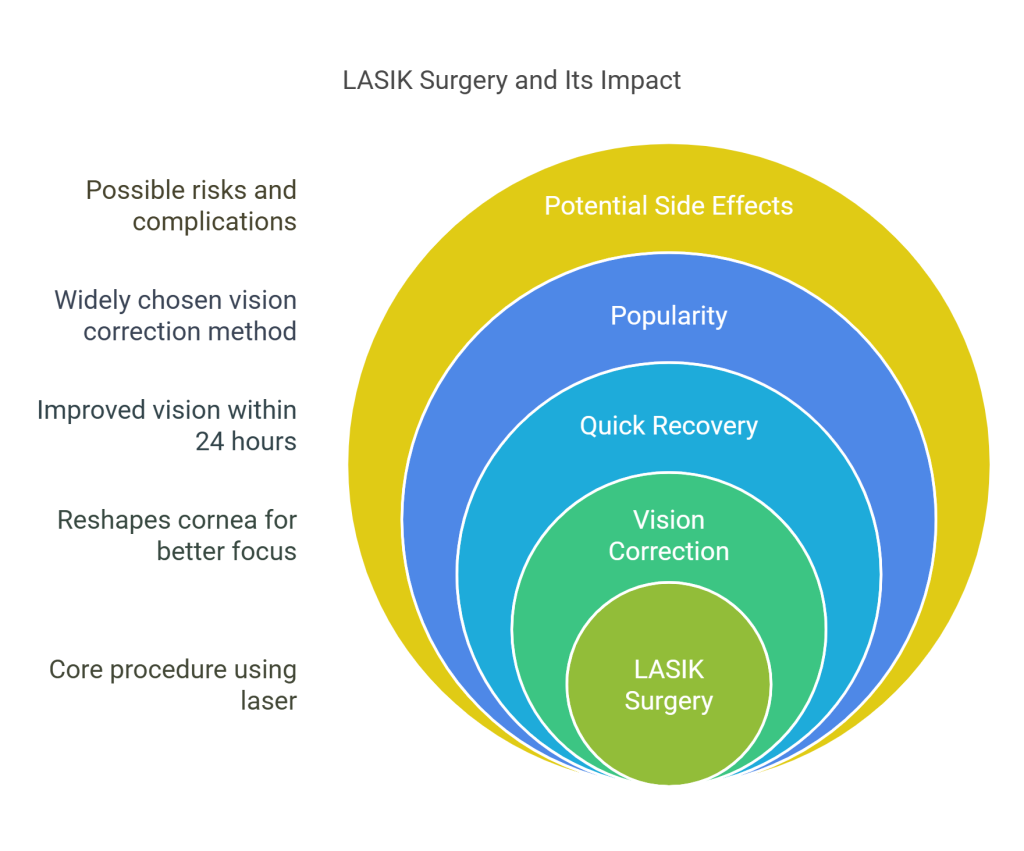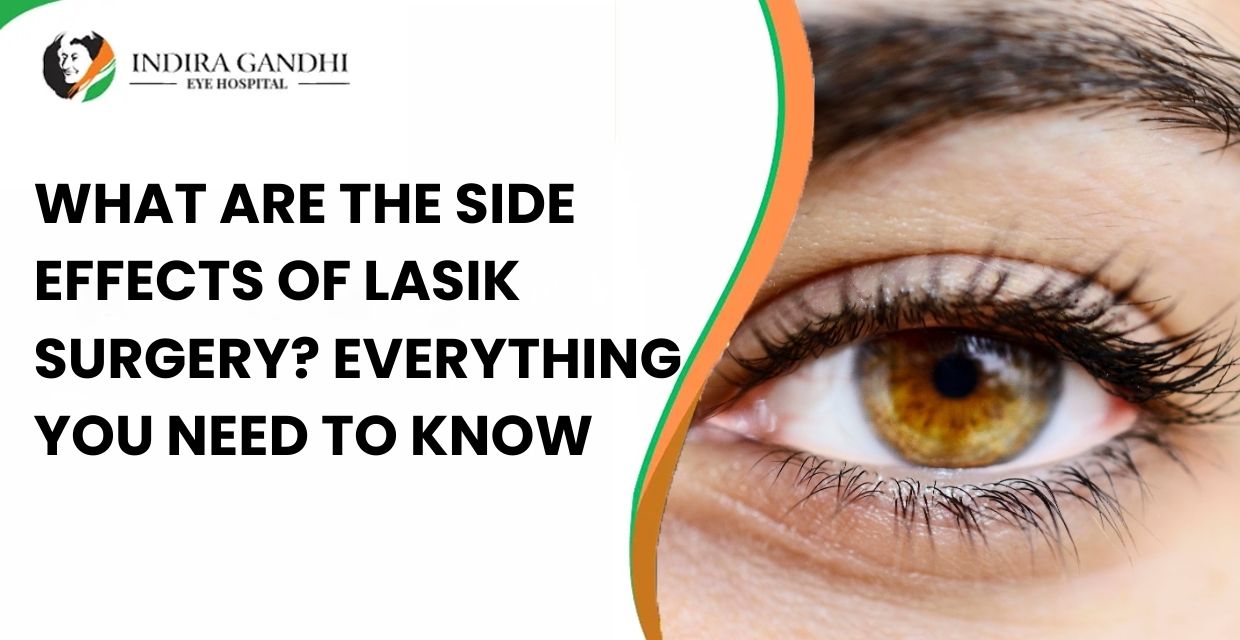|
Getting your Trinity Audio player ready...
|
LASIK surgery has revolutionized vision correction by offering a quick and effective solution for people with refractive errors such as myopia, hyperopia, and astigmatism. While millions have benefited from the procedure, potential patients often wonder, What Are the Side Effects of LASIK Surgery? In this comprehensive guide, we will delve into the side effects, risks, and important considerations to help you make an informed decision.
Understanding LASIK Surgery

LASIK (Laser-Assisted In Situ Keratomileusis) is a type of refractive surgery that uses a laser to reshape the cornea, the clear front part of the eye. By correcting the way light rays are focused onto the retina, LASIK improves vision and reduces the dependency on glasses or contact lenses. The procedure is quick, usually taking about 15 minutes for both eyes, and patients often experience improved vision within 24 hours.
This surgery has become one of the most popular and successful vision correction techniques worldwide. The combination of its precision, rapid recovery, and effectiveness has made it a preferred choice for millions of people looking to improve their quality of life. However, like any medical procedure, it comes with potential side effects, which we’ll explore in detail below.
Common Side Effects of LASIK Surgery
While LASIK is a safe and highly effective procedure, it’s important to understand the potential side effects that some patients may experience. These side effects are typically temporary and resolve as the eyes heal. Here’s an overview:
1. Dry Eyes
Dry eyes are one of the most common side effects of LASIK surgery. The procedure can temporarily reduce tear production, leading to discomfort and a gritty sensation in the eyes. Most patients experience relief with artificial tears or prescribed eye drops. For those with pre-existing dry eye conditions, your surgeon may recommend additional treatments before LASIK to minimize this risk.
The tear film plays a crucial role in maintaining eye health and clarity. After LASIK, the nerves responsible for tear production may be temporarily disrupted, leading to reduced lubrication. Regular use of artificial tears and staying hydrated can alleviate this discomfort.
2. Glare, Halos, and Starbursts
Some patients report visual disturbances such as glare, halos, or starbursts around lights, particularly at night. These effects are usually temporary and subside within a few weeks or months. In rare cases, they may persist longer and require further evaluation.
Night vision issues often arise due to changes in the cornea’s shape, which affects how light is refracted. Modern advancements in LASIK technology, such as wavefront-guided lasers, have significantly reduced the occurrence of these side effects.
3. Fluctuating Vision
It’s not uncommon for vision to fluctuate during the initial healing phase. Patients may notice periods of sharper vision followed by times of blurriness. This is a normal part of the recovery process and typically stabilizes within three to six months.
Vision fluctuation occurs as the cornea heals and the eye adjusts to its new shape. Adhering to follow-up appointments ensures any irregularities are addressed promptly.
4. Light Sensitivity
Increased sensitivity to light, known as photophobia, is another temporary side effect of LASIK. Sunglasses and avoiding bright lights during the recovery period can help manage this symptom.
Light sensitivity is more pronounced during the first few weeks post-surgery. Wearing polarized sunglasses outdoors and reducing screen time can enhance comfort during recovery.
5. Corneal Flap Complications
During LASIK, a thin flap is created on the cornea, which is then lifted for the laser reshaping process. Rarely, complications related to the flap can occur, such as wrinkles (striae) or incomplete healing. These issues are typically addressed through additional treatment or careful monitoring by your surgeon.
Proper care during the healing process, including avoiding eye rubbing and strenuous activities, minimizes the risk of flap complications.
Less Common but Serious Side Effects
While rare, some patients may experience more significant complications. It’s essential to discuss these risks with your surgeon before undergoing LASIK.
1. Undercorrection or Overcorrection
In some cases, the laser may not remove enough or may remove too much corneal tissue, leading to undercorrection or overcorrection of vision. Additional corrective procedures, known as enhancements, may be required to achieve the desired results.
2. Infection or Inflammation
Although LASIK is performed in a sterile environment, there is a minimal risk of infection or inflammation post-surgery. Using prescribed antibiotic and anti-inflammatory eye drops as directed can significantly reduce this risk.
3. Ectasia (Corneal Weakening)
Ectasia is a rare condition in which the cornea becomes weakened and bulges outward, leading to distorted vision. Patients with thin corneas or other pre-existing conditions are at higher risk, which is why thorough pre-operative evaluations are crucial.
4. Loss of Vision
In extremely rare cases, complications may result in permanent vision loss. However, this risk is minimal when the procedure is performed by a qualified and experienced surgeon.
Factors That Increase the Risk of Side Effects
Certain factors can increase the likelihood of experiencing side effects after LASIK. These include:
- Pre-existing Dry Eyes: Individuals with dry eyes are more prone to experiencing discomfort post-surgery.
- Large Pupils: People with larger-than-average pupils may be at higher risk for visual disturbances like glare and halos.
- Thin Corneas: Thin corneas may increase the risk of ectasia and other complications.
- High Refractive Error: Patients with severe nearsightedness, farsightedness, or astigmatism may face a slightly higher chance of undercorrection or overcorrection.
- Medical Conditions: Autoimmune diseases, diabetes, and other systemic conditions can affect healing and increase the risk of complications.
Your surgeon will conduct a comprehensive evaluation to determine if LASIK is right for you and discuss any specific risks based on your individual circumstances.
Managing and Preventing Side Effects
To minimize the risk of side effects and ensure a smooth recovery, follow these post-operative care tips:
- Use Prescribed Eye Drops: Follow your surgeon’s instructions for using antibiotic and anti-inflammatory drops to prevent infection and reduce inflammation.
- Avoid Rubbing Your Eyes: Rubbing your eyes can displace the corneal flap or cause irritation. Protect your eyes during the healing process.
- Wear Protective Eyewear: Sunglasses can shield your eyes from UV rays and reduce light sensitivity.
- Rest and Hydrate: Proper rest and hydration support your body’s natural healing processes.
- Attend Follow-Up Appointments: Regular check-ups with your surgeon allow for monitoring of healing and early detection of any complications.
If you’re considering LASIK surgery, explore Lasik Eye Surgery in Lucknow for expert care and advanced treatment options.
Advances in LASIK Technology
Modern advancements in LASIK technology have further enhanced the procedure’s safety and precision. Wavefront-guided LASIK offers customized treatments tailored to the unique characteristics of each patient’s eyes. Femtosecond lasers have replaced traditional microkeratomes, providing a blade-free approach to creating the corneal flap. These innovations have significantly reduced the risk of complications and improved overall outcomes.
The integration of artificial intelligence in planning and executing LASIK surgeries has also contributed to enhanced accuracy, making the procedure even safer.
Myths About LASIK Surgery
There are several misconceptions about LASIK surgery that may deter potential candidates. Let’s debunk some of the most common myths:
- Myth 1: LASIK Is Painful: The procedure is virtually painless, thanks to numbing eye drops used during surgery.
- Myth 2: Results Don’t Last: For most patients, the results of LASIK are long-lasting, with only minor age-related changes in vision over time.
- Myth 3: Everyone Is a Candidate: While LASIK is highly effective, not everyone is a suitable candidate. Comprehensive evaluations ensure the procedure is safe and appropriate.
- Myth 4: LASIK Can’t Fix Severe Vision Problems: Advancements in technology have expanded the range of treatable refractive errors, including severe cases.
Conclusion
So, What Are the Side Effects of LASIK Surgery? While the procedure is generally safe and effective, it’s essential to be aware of potential side effects and risks. Most side effects are temporary and manageable with proper care, and the likelihood of serious complications is minimal when performed by an experienced surgeon.
If you’re considering LASIK, consult with a trusted eye specialist to determine if the procedure is right for you. At Indira Gandhi Eye Hospital, we offer state-of-the-art LASIK treatments performed by highly skilled professionals. Take the first step toward clearer vision and improved quality of life today.
By understanding the side effects, benefits, and advancements in LASIK technology, you can make an informed decision and enjoy the transformative power of this life-changing procedure.












